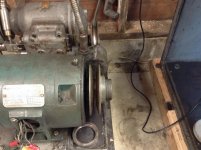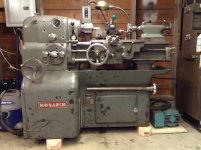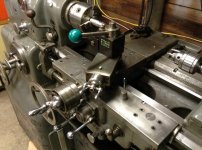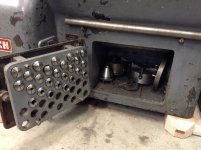mike.thomas1
Aluminum
- Joined
- Mar 24, 2015
Finally got my machine home today, thank goodness for lift gates. Its a 4/1940 ee-7120 machine. Still has the sundstrand drive but with updated motor. She sat for about 15 years since the passing of her original owner, but it was nice and cozy in a heated garage and still looks quite nice. It came complete with steady and follow rests, collets, draw bar, taper attachment, original manual, etc.
Where to begin....
The sundstrand seems finicky. Upon starting up and selecting a direction, it will often release a death rattle then start spinning. While running the pump is a little noisy but I also had all the covers off and was anxious to hear it run. The speed adjustment seems to work mainly in 3 revolutions of the crank range, then kinda freewheels. Also, I assume it reaches top speed, but I believe the rpm gauge is inaccurate since its showing only about 750rpm (sure looks like its buzzing waaaaay faster than that). There is clean looking oil in the tank, say halfway up. I have not gone through the trouble shooting steps in the manual, but I will, just hoping to hear of others experiences.
Oil oil oil. What is the preferred oil for sundstrand pumps. I saw in another post anything with an ISO-32 rating? Yes/No? That equates to 10w correct? The manual specs 10w for pretty much every oil reservoir: headstock, apron, somewhere else, but I do realizes oils were a bit different seventy six years ago. Should I seek out this ISO spec or just drain and fill with 10w?
I forgot my other questions and quirks but I'm sure ill remember once I lay down in bed. Ill get pictures up tomorrow once the shop doesn't look like a war zone.
Where to begin....
The sundstrand seems finicky. Upon starting up and selecting a direction, it will often release a death rattle then start spinning. While running the pump is a little noisy but I also had all the covers off and was anxious to hear it run. The speed adjustment seems to work mainly in 3 revolutions of the crank range, then kinda freewheels. Also, I assume it reaches top speed, but I believe the rpm gauge is inaccurate since its showing only about 750rpm (sure looks like its buzzing waaaaay faster than that). There is clean looking oil in the tank, say halfway up. I have not gone through the trouble shooting steps in the manual, but I will, just hoping to hear of others experiences.
Oil oil oil. What is the preferred oil for sundstrand pumps. I saw in another post anything with an ISO-32 rating? Yes/No? That equates to 10w correct? The manual specs 10w for pretty much every oil reservoir: headstock, apron, somewhere else, but I do realizes oils were a bit different seventy six years ago. Should I seek out this ISO spec or just drain and fill with 10w?
I forgot my other questions and quirks but I'm sure ill remember once I lay down in bed. Ill get pictures up tomorrow once the shop doesn't look like a war zone.









